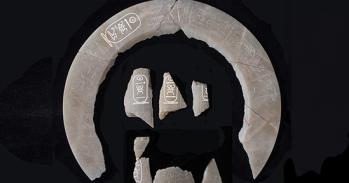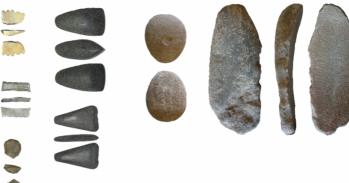
Ben Cartwright, a member of Cambridge’s Material Culture Lab, is an archaeologist whose research focuses on the ways in which the crafts of spinning and weaving are embedded into the historic culture of the islands of the North Atlantic and remain an important part of island identity.
Ben Cartwright, a member of Cambridge’s Material Culture Lab, is an archaeologist whose research focuses on the ways in which the crafts of spinning and weaving are embedded into the historic culture of the islands of the North Atlantic and remain an important part of island identity.
Craft brings people together, creating a social space where ideas are swapped and made sense of, quite literally with the hands.
Ben Cartwright
There’s a theory in the fashion world that a period of austerity or recession heralds a return to the comfort and familiarity of tried-and-tested classics. In this way, we seek solace in what we think of as our heritage. Certainly, many of the collections in the shops for this winter feature designs that have their roots in the craft-based industries of the rugged islands in the north Atlantic that gave their names to some of the styles most closely associated with traditional British clothing – Harris, Shetland, Fair Isle. Today these iconic styles are widely copied by mass market producers while the craft industries which developed them struggle to remain viable, the weaving of tweed on the islands of Lewis and Harris being a notable exception. However, they continue to define the way the places and people of the isles are thought of. For the practitioners too, making plays an important social role in how they see themselves.
For thousands of years, the process of becoming an adult was for most people rooted in what they did, in craft-based activities, learning through making. Craft brought people together. Traditionally this crafting was especially important in the rural communities of the north, where seasonal demands meant that people spent a large amount of time working on their own. It was often joked, for example, that husbands and wives were only seen together in some of these tasks such as the rooing (plucking the wool) of sheep, or carding (untangling) the wool. Centres of making became centres of meeting. For young people growing up in these societies, the environment itself was their classroom and the community their teacher as they absorbed the practical skills needed to enable them to making a living from the resources around them.
Ben Cartwright is a member of the The Material Culture Lab in Cambridge University’s Department of Archaeology. The Material Culture Lab is a small group of researchers dedicated to the social study of things from the past. He is interested in the ways in which cloth production was linked to social identity for the island populations of Atlantic Scotland between 600 AD and 1200 AD. This was a period of considerable social change. It begins with the birth of the Viking Age, the creation of various chiefdoms in the Northern and Western Isles who interfered with political events of the age, notably through the creation of the Earldom of Orkney which acted like a firebrand across the skies of the early Viking world. Historically, the sagas record Earls raiding and taking possession of territory as far down as the Isle of Man. Earlier Irish sources record the activities of war bands of mixed Scandinavian and Hebridean descent as ‘foreign Gaels’.
The ebb and flux of these piratical Chiefdoms end in what in Atlantic Scotland might be called the early middle ages, when the Isles functioned as colonial possessions of the Kings of Norway, who subjugated their troublesome neighbours across the sea. Modern sailing yachts make the crossing in the annual race from Bergen, Norway, to Lerwick, Shetland, in less than 24 hours; in the Viking Age the same voyage would have taken at least two days and nights on the open water and involved far greater danger. Modern crews rely on all manner of engineered man-made fabrics for canvas, rope and notably sailcloth, as well as their protective clothing; in the past all of these items were made by hand from natural materials.
Cartwright’s research explores the ways in which the crafts of spinning and weaving, as ‘learnt bodily histories’ (performing the task requires the learning of certain repetitive body movements and behaviours), contribute to community and individual identity. He is interested in how these crafts shape the means by which people behave and present themselves to themselves and others - not least in the clothes they wore.
“My work looks not just at the ways in which skills and traditions were passed down across the generations but also the central role that crafts played in terms of how people created a community – something that you might describe as ‘islandness’. Craft brings people together, creating a social space where ideas are swapped and made sense of, quite literally with the hands. As apprentices learnt new techniques, which, especially at the loom, could be painful and body altering, it also changed their minds, the way they thought and saw the world around them. They took on and participated in re-making community narratives, the stories, gossip and opinions that made sense of their place in the world. Bringing the past into the present,” said Cartwright.
“To study these communities of makers, and how their ideas changed over time, I look at the objects from the period, such as loom weights and spindle whorls. Lumps of stone, that are so often ignored, can be measured to show the qualities of what they were used to produce, yarn and cloth, and how techniques of making differed over time. A history of learnt body techniques provides a different way of looking at how social ideas shifted or remained. New clothes, styles and sails needed new ways of making, and reasons or motivation to make them. We need new clothes because we want to look like x or y, usually a social ideal or a fashion. We learn to move our fingers in new ways because we want new clothes. These changes were made sense of in relation to their own social histories and the events in the world around them.”
Survival in northern climates depended on the fabrication of materials that protected from wind, rain and cold. Craftsmen looked to the landscape to provide materials for the looms, stones to use as loom weights, fibre to spin into yarn, vegetable matter to use in dyes. The demands from the loom would have sent people out into different parts of the environment at different times of the year, creating a rhythm of interaction. “Anyone who has spent time in the Isles will tell you how animate a presence the wind and weather can be. To fulfil these tasks people needed the right clothing, and other items from sacking all the way through to sails,” said Cartwright.
“Cloth is much more than functional: it is imbued with the spirit of those who make it and those who wear it, use it, or sleep beneath it. There’s evidence in the Viking Age that the processes of spinning and weaving were tied into the spirituality and belief systems of the time. We know many myths and ideas, sometimes carved onto spindle whorls, gave religious and historical importance to the activity. And it is very likely that the spinners and weavers would have known and ‘re-spun’ these ideas, giving significance to what they were doing. They were re-weaving the spiritual world for their families and communities, clothing them in meaning.”
The transformation of a greasy fleece or flax stems into a garment was an intensive practice often involving thousands of hours of labour. The skills required to do this involved a sensory engagement with materials in terms of what it is possible to do with them, how they behave and how to manipulate them, processing raw materials into items of desire, twisting colours together in a way that mirrors the subtle beauty of the landscape. “Many of these ideas would have been passed down, from generation to generation. Body techniques full of meaning, superstitions and practices acted as a social skill set. How these changed - or didn’t - is key to understanding how the islanders created a sense of ‘us’ in this period of social upheaval,” said Cartwright.
Clothing is one of the ways in which people, or groups of people, make themselves distinctive. This is likely to have been as true a thousand or so years ago as it is today. When people take on different roles, new clothes give them new ways of behaving. The tailoring, material, and weave of the cloth restrict or emphasise certain movements that made up a social system of manners. Ways of being structured the social relations central to a creating sense of home, and an ‘us’.
Cartwright summed up: “You could even say that the clothing wears the body, gives it certain habits. And just as fashion trends change today as the results of influences both within and beyond communities, so they would have done so in the past. Though seemingly remote to our modern road-based way of thinking, and sometimes cut off from surrounding places by storms, the islands of Atlantic Scotland were in the middle of one of the busiest shipping, and therefore of all transport, routes of the age– and this interconnectedness reveals itself in some of the material choices of the Islanders. Not least at the loom.
"It was this ability to participate in the historic changes of the age, that re-forged the political maps of Britain and Ireland, as well as maintain a distinctive localised identity, a ‘heritage’ bound up in cloth, that makes the islanders of the time so fascinating.”
This work is licensed under a Creative Commons Licence. If you use this content on your site please link back to this page.





